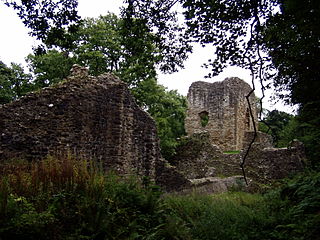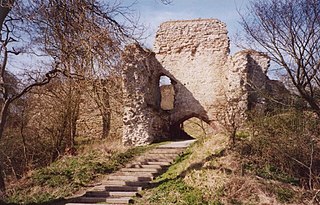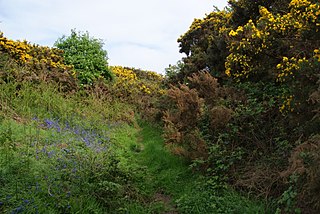The Lauenburg is a ruined medieval castle in the East Harz in central Germany situated on an elevation southwest of the village of Stecklenberg (in the borough of Thale) in Harz district in the state of Saxony-Anhalt in the former German Democratic Republic (East Germany).
The castle was built in the High Middle Ages.
The ruins of the Lauenburg stand on a foothill of the Ramberg massif above the village of Stecklenberg. It was built by Henry IV and first mentioned in the records in 1164. The construction of the two-part castle with its inner and outer wards (Vorburg and Hauptburg) probably took up to ten years. The two halves of the castle are separated by a massive defensive ditch (a neck ditch or Halsgraben), hewn out of the rock. The purpose of this impressive fortification with a total length of more than 350 metres was the protection of Quedlinburg and the nearby military roads. In 1180 the Lauenburg was captured by Frederick I (Barbarossa) during a series of warlike conflicts. Later robber barons resided in the castle for periods of time, until it was destroyed in the 14th century.
Today the main castle is badly run-down. Only a few remnants of the towers and the outer walls are still left. The only structure in the entire fortification that has withstood the ravages of time and history relatively well is the keep of the outer ward. Its ruins can be seen from a long way off.
The Lauenburg has a checkpoint (no. 187) in the network of hiking trails that form the Harzer Wandernadel. It is on the path by the entrance to the inn that is situated between the two parts of the castle.

Ogmore Castle is a Grade I listed castle ruin located near the village of Ogmore-by-Sea, south of the town of Bridgend in Glamorgan, South Wales. It is situated on the south bank of the River Ewenny and the east bank of the River Ogmore.

The Harzburg, also called Große Harzburg, is a former imperial castle, situated on the northwestern edge of the Harz mountain range overlooking the spa resort of Bad Harzburg in Goslar District in the state of Lower Saxony, Germany. It was erected from 1065 to 1068 at the behest of King Henry IV of Germany, slighted during the Saxon Rebellion in 1073-75, and a century later rebuilt under Emperor Frederick Barbarossa and his Welf successor Otto IV, who died here in 1218.

Ewloe Castle is a native Welsh castle built by the Kingdom of Gwynedd near the town of Ewloe in Flintshire, Wales. The castle, which was one of the last fortifications to be built by the native Princes of Wales, was abandoned at the beginning of the invasion of Wales by Edward I in 1277. Its construction, using locally quarried sandstone, appears to have continued piecemeal over many years and may have not been completed. On taking the castle, the English Crown gave it little military value and allowed it to fall into ruin.

Pickering Castle is a motte-and-bailey fortification in Pickering, North Yorkshire, England.

Pevensey Castle is a medieval castle and former Roman Saxon Shore fort at Pevensey in the English county of East Sussex. The site is a Scheduled Monument in the care of English Heritage and is open to visitors. Built around 290 AD and known to the Romans as Anderitum, the fort appears to have been the base for a fleet called the Classis Anderidaensis. The reasons for its construction are unclear; long thought to have been part of a Roman defensive system to guard the British and Gallic coasts against Saxon pirates, it has more recently been suggested that Anderitum and the other Saxon Shore forts were built by a usurper in an ultimately unsuccessful attempt to prevent Rome from reimposing its control over Britain.

Wigmore Castle is a ruined castle about 1 km (0.62 mi) from the village of Wigmore in the northwest region of Herefordshire, England.

Montfort is a ruined Crusader castle in the Upper Galilee region in northern Israel, about 22 miles (35 km) northeast of the city of Haifa and 10 miles (16 km) south of the border with Lebanon.

Uhlenburg is the site (Burgstall) of a lowland castle that was built in the 14th century close to the River Aller near Essel in the German state of Lower Saxony. This Late Middle Ages aristocratic seat only existed for a few decades towards the end of the 14th century and was destroyed by force in 1393/94.

Castell Gwallter, also known as Walter's Castle and sometimes Castell Penweddig, is the remains of a Norman motte-and-bailey castle situated on a large hill above the old village of Llandre in northern Ceredigion, Wales, four miles northeast of Aberystwyth.

Anhalt Castle is a ruined medieval fortification near the town of Harzgerode in Saxony-Anhalt, Germany.

The Stecklenburg is a ruined medieval castle in the East Harz in Germany, located on a small rise only a few hundred metres away from the village of Stecklenberg in the district of Harz in Saxony-Anhalt.

Grubenhagen Castle is a ruined medieval castle in North Germany dating to the 13th century. It is not far from the town of Einbeck in southern Lower Saxony.

A bailey or ward in a fortification is a courtyard enclosed by a curtain wall. In particular, an early type of European castle was known as a motte-and-bailey. Castles can have more than one bailey. Their layout depends both on the local topography and the level of fortification technology employed, ranging from simple enclosures to elaborate concentric defences. In addition to the gradual evolution of more complex castle plans, there are also significant differences in regional traditions of military architecture regarding the subdivision into baileys.

The Ackeburg, also called the Ackenburg, in the Harz Mountains of central Germany, is the site of a high medieval hill castle, 333.2 m above sea level (NN), in the borough of Falkenstein/Harz in Harz district in the state of Saxony-Anhalt. It was first mentioned in 1216 and was abandoned or destroyed in 1400. There was also a village associated with it, known as Akkeburg.

Old Falkenstein Castle in the Harz Mountains of Germany is the castle site or burgstall of a high medieval hill castle. It lies on the territory of Falkenstein/Harz in the state of Saxony-Anhalt in the district of Harz. It was built in the 11th century A.D. and destroyed in 1115.

Altenstein Castle is a ruined castle in Altenstein in the district of Haßberge in Lower Franconia, Germany. The family seat of the lords of Stein zu Altenstein, which died out in the 19th century, is located 40 kilometres north of the city of Bamberg and, since the end of the 20th century, has been managed by the district of Haßberge. The castle was renovated around the turn of the millennium.

The ruins of Alt-Trauchburg Castle, also called the Alttrauchburg or Trauchburg, lie above the Weitnau hamlet of Kleinweiler in the county of Oberallgäu in Swabia. Large parts of the original stone walls of the high- to post-medieval castle remain. The ruins are some of the best preserved in the Allgäu region of Germany.

The Wohldenberg Castle is a ruin, located about one kilometer southwest of the small town Sillium. Sillium belongs to the municipality Holle in the district of Hildesheim. Sillium’s emblem shows also the castle complex.

Hohenfreyberg Castle, together with Eisenberg Castle directly opposite, forms a castle group in the southern Allgäu that is visible from a long way off. It is located about four kilometres north of Pfronten in the county of Ostallgäu. The late mediaeval hilltop castle was abandoned during the Thirty Years’ War and set on fire. From 1995 to 2006 the former aristocratic seat was comprehensively made safe and conserved as part of a closely observed "example of renovation".

On a hill spur above the Eifel village of Monreal in Germany's Elzbach valley, at a height of 350 m above sea level (NHN), stand two neighbouring ruined hill castles: the Löwenburg, also called Monreal Castle, and the Philippsburg. The latter is also known locally as das Rech.



























